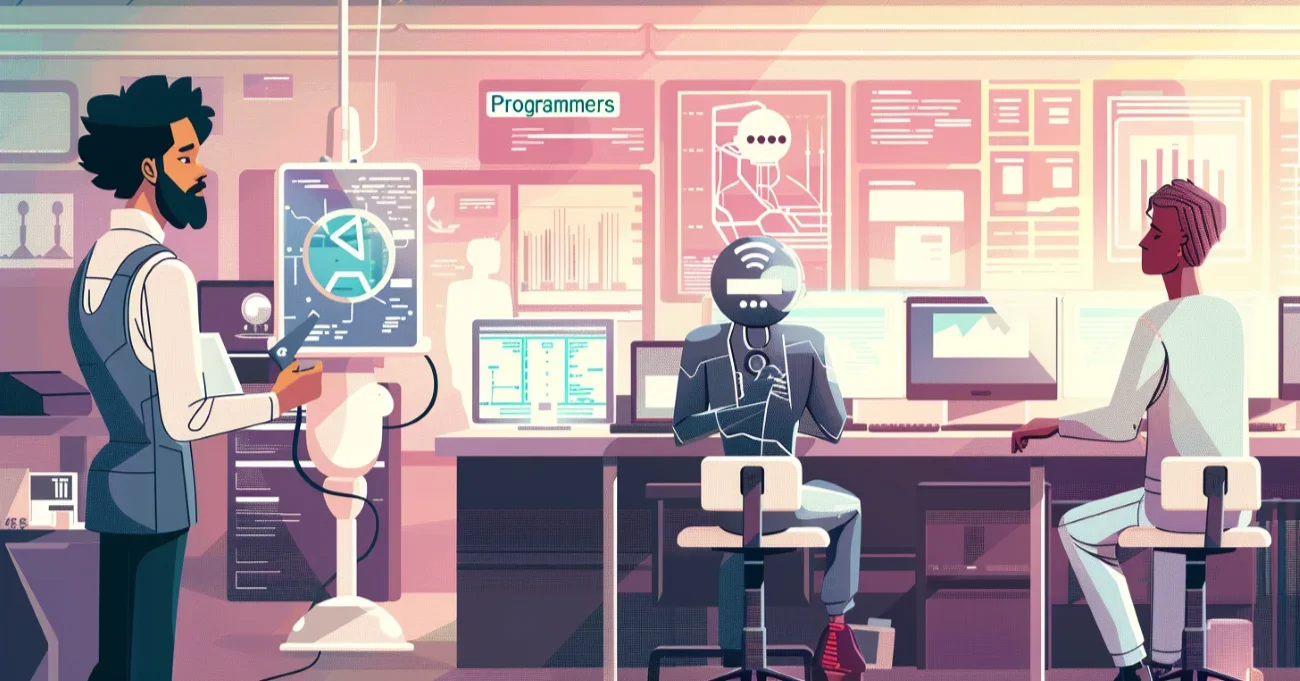Analyzing the question, “Will AI replace programmers?” involves the interplay of technological advancement and human creativity. While AI technologies continue to advance, programmers' unique problem-solving abilities and creative insights remain indispensable. With the right skills and capabilities, individuals can adapt and thrive in the changing tech landscape, leveraging AI to augment their programming skills rather than viewing it as a threat to their roles.
At Aloa, we recognize the transformative potential of AI in software development. Rather than viewing AI as a threat to programmers, we see it as a powerful tool that complements their skills and enhances their capabilities. Our focus is empowering programmers with AI tools and techniques to amplify their productivity, accelerate development cycles, and drive meaningful advancements in the field.
Drawing upon our deep understanding of the tech industry, we've created this guide to explore if AI will truly replace programmers, offering viewpoints to assess risks and opportunities in your career. We’ll go into the factors determining the outcome, pinpoint the boundaries AI faces in its potential to replace humans, and offer strategies for integrating AI into programmers' work routines. After reading, you'll have new perspectives on how the role of programmers is evolving in the digital age and how you can adapt to this.
Let’s get started!
Will AI Replace Programmers?
AI is undeniably a powerful asset in software development, particularly its ability to optimize and automate repetitive tasks. Will AI replace programmers? Sure, it's excellent at automating stuff, but nothing beats the human touch regarding the nitty-gritty of problem-solving, creativity, and understanding what users want.
The symbiotic relationship between AI and human developers is essential for achieving optimal results in software development. While AI excels in automation, human creativity and empathy remain indispensable for driving innovation and establishing meaningful user connections. This dynamic blend enhances experiences and tackles real-world challenges head-on, ensuring your success in the ever-evolving software development landscape.
Key Industry Factors That Will Determine the Outcome
Considering whether AI will replace programmers is essential as AI emerges as a central force, transforming development processes with numerous advantages. Knowing the key factors driving AI's impact in software engineering is necessary to thrive in the digital age and tap into its potential for innovation and progress. Explore these key industry factors to stay ahead in the game and unlock new possibilities in software development:
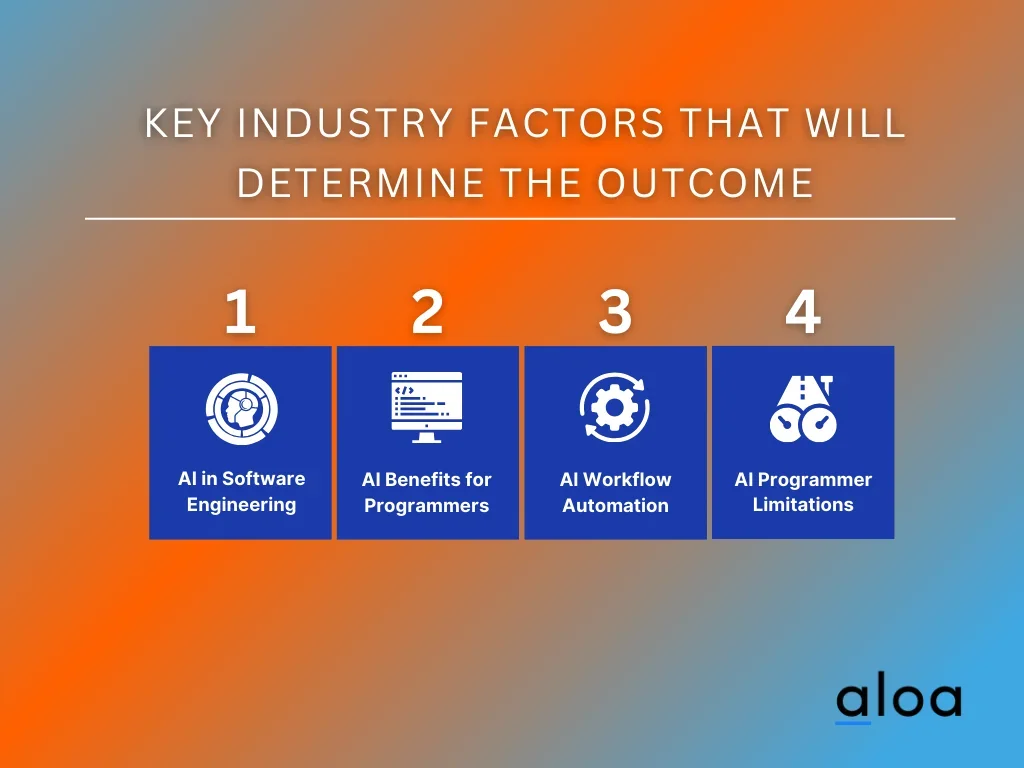
AI’s Increasing Role in Software Engineering
AI is shaking up software engineering, changing how we develop software, and ushering in a fresh wave of innovation. With its powerful machine learning and data analysis abilities, AI has transcended mere hype to become an essential tool reshaping all aspects of software development.
Amidst all this change, everyone's buzzing about whether AI will replace programmers. Check out these key elements illustrating AI's pivotal role in software engineering:
- Automation of Routine Tasks: AI algorithms streamline tasks like code generation, testing, and debugging, reducing manual effort and boosting productivity when using AI-powered automation testing tools. This allows software engineers to create strategic plans and solve potential problems, leading to efficient development processes.
- Optimization of Code Quality: AI-powered code analysis tools detect vulnerabilities, inefficiencies, and potential bugs, enhancing the overall quality and reliability of software products. Through advanced algorithms, AI assists in refining code structure and adherence to coding standards, ensuring cleaner and more maintainable codebases.
- Data-Driven Decision Making: AI algorithms analyze large datasets to extract valuable insights, facilitating informed decision-making throughout the software development lifecycle. Predictive analytics help software engineers anticipate user needs, allocate resources effectively, and prioritize feature development for enhanced user satisfaction.
- Intelligent Debugging and Troubleshooting: AI-driven debugging tools swiftly identify and rectify coding errors, minimizing downtime and enhancing software reliability. Real-time monitoring and anomaly detection capabilities empower engineers to address potential issues proactively, ensuring smoother deployment and maintenance processes.
- Personalized User Experiences: AI algorithms analyze user behavior, customizing software interfaces and functionalities for enhanced engagement and satisfaction. AI-driven applications foster loyalty by delivering customized recommendations and adaptive interfaces, ensuring a tailored user experience.
- Continuous Learning and Adaptation: AI-powered systems evolve iteratively through constant learning from user feedback and performance data. Adaptability to changing environments and user demands enables AI-driven software to remain relevant and competitive in dynamic markets.
- Ethical and Regulatory Considerations: The increasing prominence of AI in software engineering raises ethical concerns regarding data privacy, bias mitigation, and algorithmic transparency. Addressing these concerns requires proactive measures such as ethical frameworks and bias detection algorithms to ensure responsible AI deployment and mitigate societal risks.
- Future Perspectives and Innovations: The rapid advancement of AI technologies offers several opportunities for innovation in software engineering. Emerging trends like AI-driven software synthesis and autonomous code generation suggest a future where AI fundamentally reshapes the software development landscape.
The Growing Benefits of AI for Programmers
Developers can achieve unprecedented efficiency gains, empowering them to focus on creative problem-solving and innovation by harnessing the power of AI. From debugging code to optimizing workflows, AI tools augment programmers' skills and enhance code quality, driving a more dynamic software development process.
Amidst discussions about whether AI will replace programmers, it's clear that exploring these benefits sheds light on just how transformative AI can be for programmers:
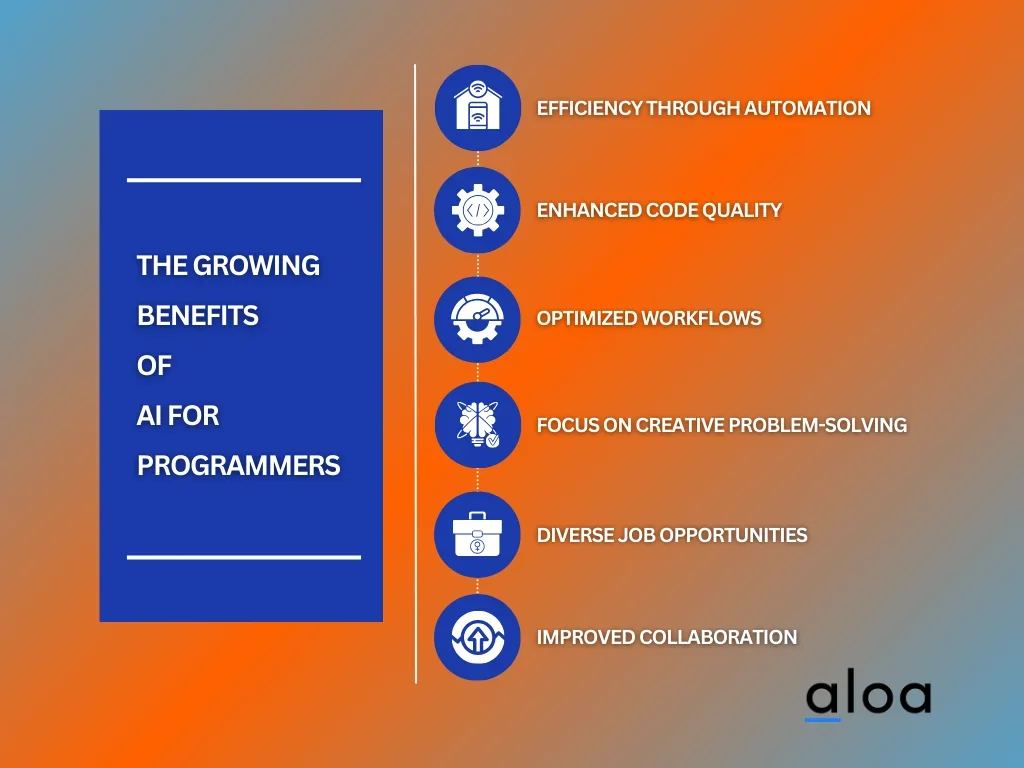
Efficiency Through Automation
AI optimizes software development workflows, boosting productivity and precision by automating tasks and offering decision-making insights. It assigns tasks based on team skills, tracks progress, and pinpoints bottlenecks for efficiency and quality enhancement. Additionally, the integration of a realistic avatar creator can streamline the user interface design process, allowing for more intuitive and engaging interaction in software applications.This means that AI indeed transforms software development, ensuring outstanding results and project success.
Enhanced Code Quality
AI takes code quality to new heights with its advanced algorithms and data analysis prowess. It minimizes bugs and vulnerabilities, ultimately improving the overall user experience by enhancing reliability and efficiency,
Optimized Workflows
Integrating AI in software development leads to optimized workflows, increasing productivity and precision. AI enhances efficiency throughout development by automating tasks and offering decision-making insights. Intelligent systems, pivotal components within business intelligence, adeptly allocate tasks according to team members' skill sets while monitoring real-time progress.
Focus on Creative Problem-Solving
AI's integration for creative problem-solving revolutionizes software development by analyzing extensive datasets, recognizing patterns, and suggesting innovative solutions. This approach enables programmers to focus on intricate problems, fostering critical thinking, while AI handles repetitive tasks. This tag-team effort between AI and human developers takes problem-solving to the next level, paving the way for game-changing solutions in the tech world.
Diverse Job Opportunities
Integrating AI into programming opens up various job opportunities across multiple industries. In-demand roles encompass AI specialists, machine learning engineers, and data scientists, as software companies prioritize the development of cutting-edge systems.
Moreover, emerging positions like AI ethicists and project managers are gaining prominence, reflecting the evolving landscape of AI integration. Industries like healthcare, finance, and e-commerce are actively seeking AI-proficient individuals, showcasing AI's expanding influence and providing plentiful career opportunities.
Improved Collaboration
AI facilitates improved collaboration between programmers and systems, resulting in synergistic outcomes. It empowers programmers to make informed decisions by swiftly analyzing vast datasets. Considering whether AI will replace programmers, this collaborative approach ensures that AI enhances rather than replaces human skills.
With AI caring for routine tasks and providing insightful support, programmers can dive into creative problem-solving. This dynamic partnership fuels heightened productivity, smooth workflows, and the birth of innovative solutions in software development. Together, AI and human innovation are pushing the boundaries of what's possible in the digital world.
AI and Workflow Automation not Replacement
AI and workflow automation enhance process efficiency without replacing human programmers. They tackle repetitive tasks, freeing up software engineers for complex problem-solving and innovation. While there is speculation surrounding the potential for AI to replace programmers, it's evident that AI and human programmers play complementary roles in optimizing workflow.
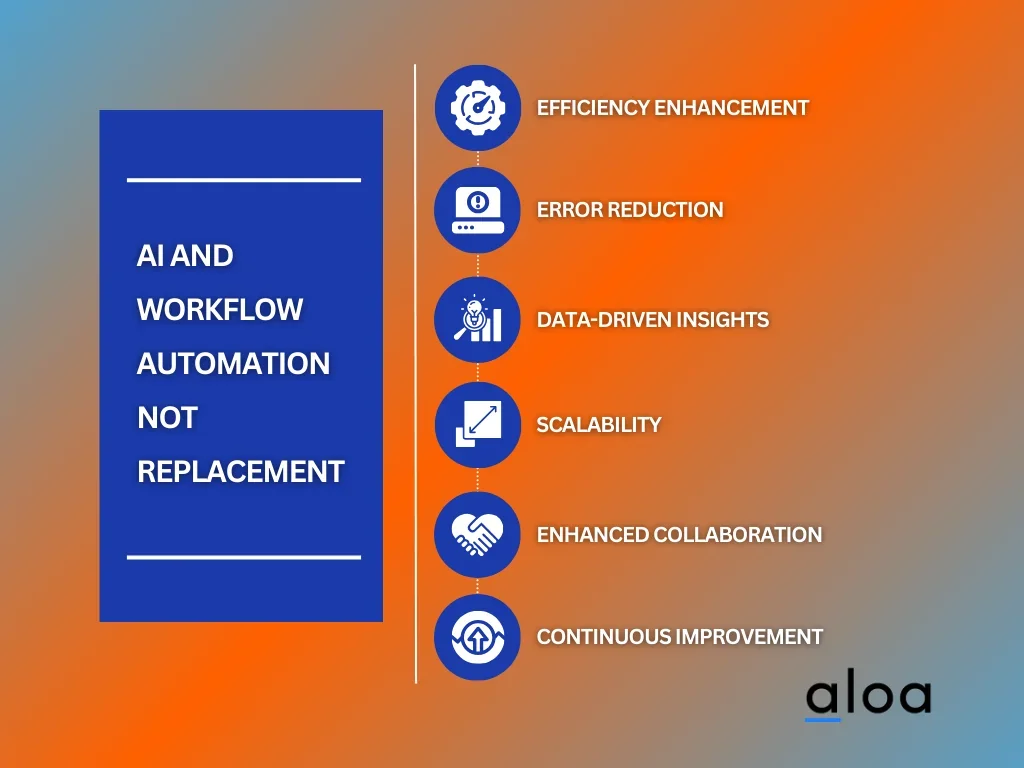
Here are the key factors that showcase the power of AI and workflow automation:
- Efficiency Enhancement: AI and workflow automation streamline software development by automating tasks like code deployment and testing, freeing up programmers for more challenging work. This approach slashes time-to-market and boosts overall project efficiency significantly.
- Error Reduction: Human error is inevitable, yet AI-powered automation can mitigate its effects. With continuous monitoring and intelligent decision-making, AI systems swiftly identify and rectify mistakes in real time, guaranteeing the delivery of top-notch software products.
- Data-Driven Insights: AI analyzes vast data, offering valuable insights into software development. Leveraging these insights, teams make informed decisions, optimize workflows, and drive better outcomes.
- Scalability: As software projects expand, manual processes become cumbersome. AI and workflow automation provide scalable solutions that seamlessly adapt to evolving project needs. Whether a small-scale project or enterprise-level system management, these technologies ensure consistent performance and reliability.
- Enhanced Collaboration: AI tools improve team collaboration by providing centralized platforms for communication, project management, and knowledge sharing. This streamlines collaboration within development teams, leading to smoother workflows and expedited project delivery.
- Continuous Improvement: Machine learning algorithms learn from data and optimize processes over time. Through constant analysis of performance metrics and user feedback, AI-driven systems iteratively refine workflows, leading to incremental improvements in productivity and software quality.
Limitations of AI in Replacing Human Programmers
While AI has made strides, completely replacing human programmers is still a complex hurdle to overcome. The complexity of programming tasks and humans' unique skills make it a challenging feat for AI. Consider these critical limitations of AI in replacing human programmers:
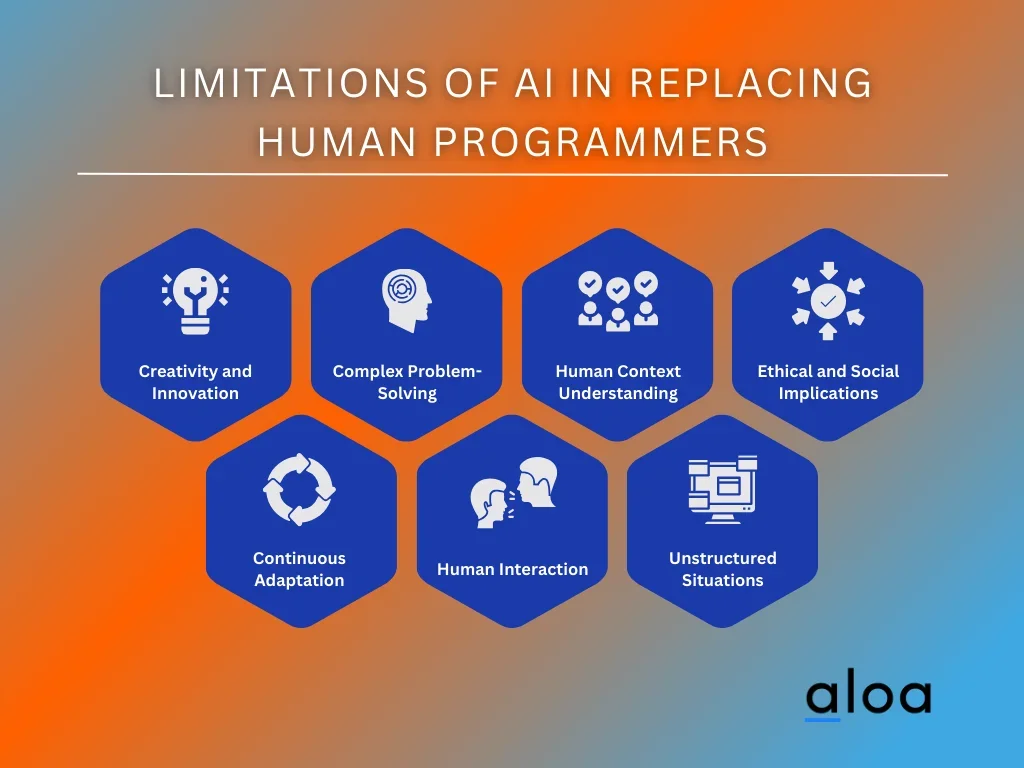
Creativity and Innovation
While AI is great at automating tasks and crunching numbers, it can't match the creative prowess of human programmers. Programmers bring unique skills like brainstorming new ideas, crafting innovative solutions, and adapting to change that AI can't quite pull off yet.
Complex Problem-Solving
AI is proficient at solving well-defined problems based on existing patterns and data. However, it needs help with complex, ambiguous problems that require abstract reasoning, intuition, and deep contextual understanding, where human programmers excel.
Human Judgment and Contextual Understanding
Programmers have the knack for making judgment calls, balancing trade-offs, and grasping the bigger picture in software projects. They consider user needs, business demands, and ethical concerns, areas where AI algorithms often fall short.
Ethical and Social Implications
AI lacks ethical reasoning and moral judgment, making it unsuitable for addressing ethical dilemmas and social implications inherent in software development. Human programmers are responsible for considering the ethical implications of their code and ensuring that AI systems operate ethically and responsibly.
Continuous Learning and Adaptation
Programmers continuously learn and develop skills to keep pace with evolving technologies and industry trends. They possess the ability to learn new programming languages, frameworks, and methodologies, which is something AI still struggles to match.
Human Interaction and Communication
Programmers thrive on teamwork, client meetings, and stakeholders’ engagement, where strong communication skills are essential. While AI excels in certain areas, it needs the ability for meaningful human interaction and nuanced communication, which limits its role in some aspects of software development.
Unforeseen and Unstructured Situations
AI excels in structured environments with well-defined rules and patterns. However, it struggles in unstructured and unpredictable situations where human judgment, creativity, and adaptability are crucial.
How Programmers Can Incorporate AI into their Workflow
Incorporating AI into your workflow can significantly boost your capabilities and efficiency, unlocking fresh pathways for innovation and productivity as a programmer. With AI tools, tasks that may have seemed overwhelming can now be automated, freeing up your time to concentrate on high-impact work. Here are some essential steps to smoothly integrate AI into your programming workflow:
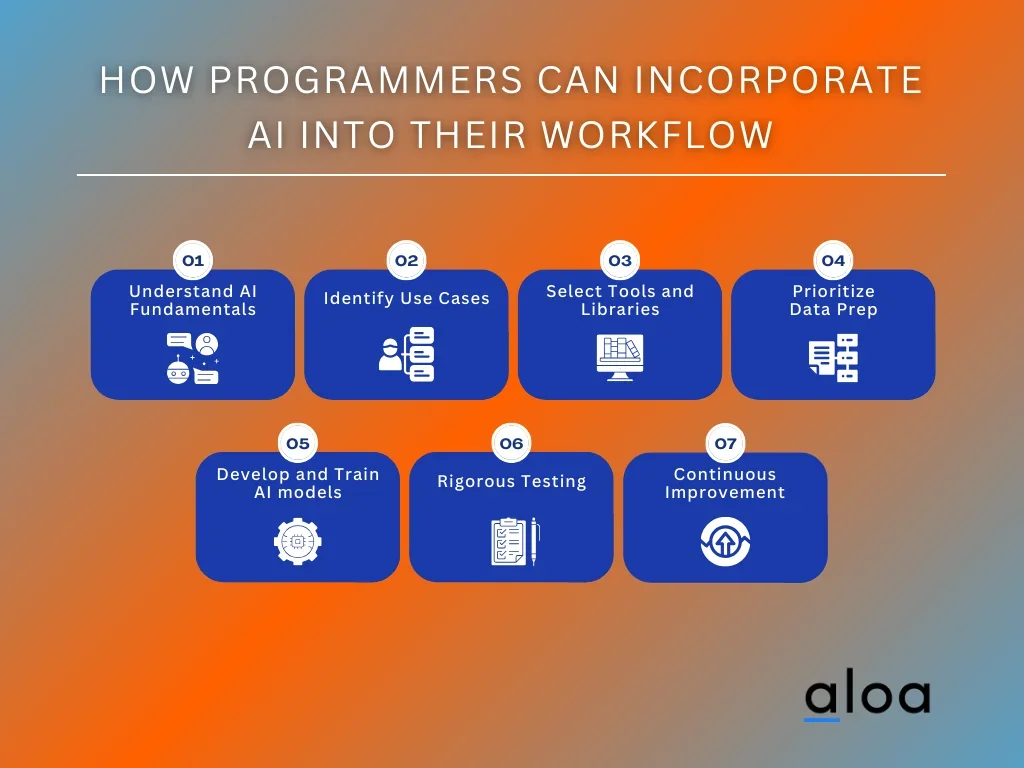
Step 1: Understand AI Fundamentals
Start by grasping the broad concept of AI, which refers to the simulation of human intelligence processes by machines, typically computer systems. This foundational knowledge provides the basis for the effective utilization of AI technologies.
Explore these core principles, algorithms, and applications of AI to develop a solid understanding of its capabilities and potential impact across various industries:

- Machine Learning (ML): Machine learning is a subset of AI that enables systems to learn and improve from experience without being explicitly programmed. Explore various algorithms like supervised, unsupervised, and reinforcement learning.
- Data: Recognize the importance of data in AI. Data serves as the fuel for training AI models. Learn the concepts related to data collection, preprocessing, labeling, and augmentation.
- Algorithms and Models: Familiarize yourself with various AI algorithms and models. This approach includes understanding neural networks, decision trees, support vector machines, and deep learning architectures like convolutional neural networks (CNNs) and recurrent neural networks (RNNs).
- Tools and Frameworks: Explore popular AI development tools and frameworks such as TensorFlow, PyTorch, sci-kit-learn, and Keras. These tools provide a robust foundation for building and deploying AI applications efficiently.
- Ethical and Social Implications: Gain insight into AI technologies' ethical and social implications. Understand the potential biases inherent in AI systems and the importance of designing and deploying AI ethically and responsibly.
- Practical Applications: Study real-world applications of AI across various industries, including healthcare, finance, automotive, retail, and entertainment. Understanding how AI is utilized in different domains can inspire innovative solutions in your projects.
Step 2: Identify Use Cases
Once you’re done understanding the fundamentals of AI, it’s time to identify appropriate use cases for integrating AI into programming. Programmers can harness this technology adeptly by pinpointing areas within software development where AI can augment efficiency or resolve intricate challenges. Here are some use cases where AI can supercharge efficiency and tackle those tough challenges head-on:
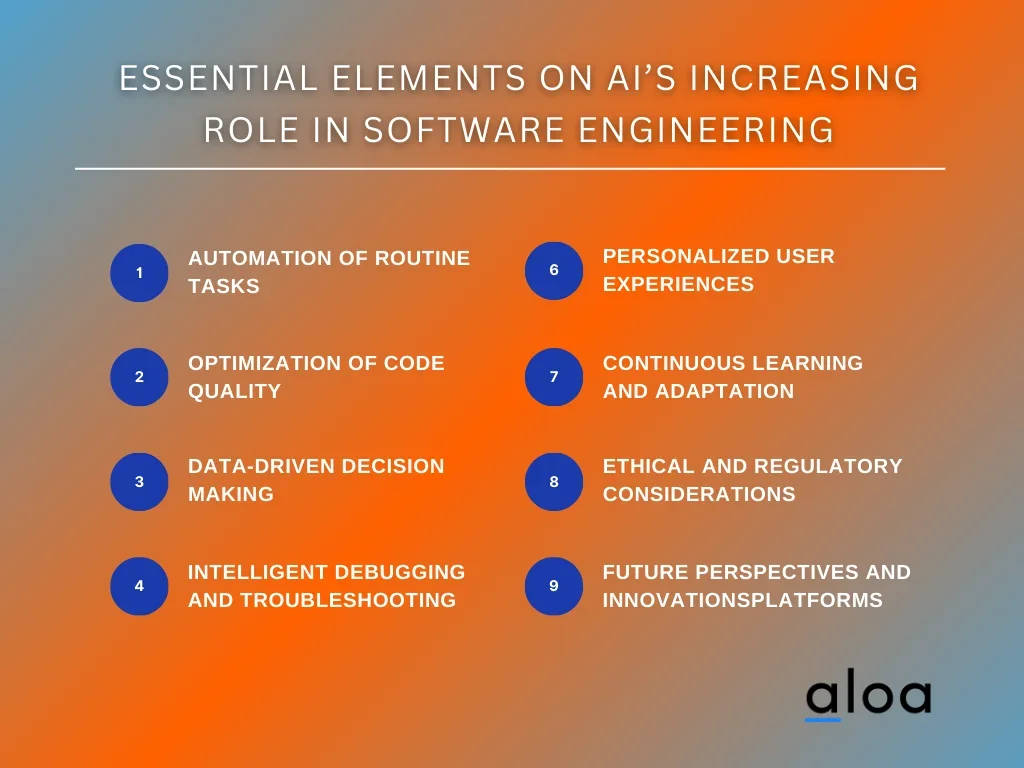
- Automation of Repetitive Tasks: AI can automate routine tasks in software development, such as data preprocessing, code refactoring, or test case generation, freeing up valuable time for developers.
- Predictive Analytics: AI-powered predictive analytics can be applied to forecast software performance, user behavior, or resource utilization, aiding in proactive decision-making and resource allocation.
- Natural Language Processing (NLP): NLP algorithms enable applications to understand and generate human language, facilitating tasks like code summarization, documentation generation, or chatbot development.
- Image and Video Processing: AI techniques like computer vision enable applications to analyze and process images and videos, which are helpful for object detection, image classification, or video editing.
- Anomaly Detection: AI-based anomaly detection systems can identify unusual patterns or outliers in software logs, helping detect security breaches, performance issues, or abnormal user behavior.
- Personalization Systems: AI-driven recommendation engines can enhance user experience by providing personalized content, product recommendations, or feature suggestions based on user preferences and behavior.
- Optimization Algorithms: AI optimization algorithms can optimize various aspects of software development, such as code performance, resource utilization, or project scheduling, leading to improved efficiency and resource management.
- Quality Assurance and Testing: AI can assist in automating software testing processes, including test case generation, bug detection, or regression testing, ensuring the reliability and stability of software applications.
Step 3: Select Tools and Libraries
Now that you've mapped your use cases, choose the tools and libraries to bring your ideas to life. You should have great choices available, such as TensorFlow, PyTorch, and OpenCV, in your toolkit. These tools are renowned for their robust functionalities and vast collections of pre-built models, covering everything from deep learning to computer vision tasks.
But before you make your final decision, consider your project specifications and language preferences. Learn each tool's features, integration ease, scalability, community support, compatibility, and cost. A bit of thorough research ensures you'll pick the perfect tools for seamless AI integration.
Step 4: Prioritize Data Collection and Preparation
With your selected tools and libraries, it's time to dive deep into data collection and preparation. Effective AI programming hinges on prioritizing data collection and preparation. This foundational step sets the stage for successful AI integration and development, fostering innovation in the tech sector.
Check out these several factors to consider when prioritizing data collection and preparation for successful AI programming:
- Relevance of Data: Ensure the collected data is directly relevant to the addressed problem. Irrelevant or extraneous data can lead to noise and decrease the accuracy of AI models.
- Data Cleanliness: Clean and preprocess the data to remove inconsistencies, errors, or missing values. This approach ensures that AI models can effectively learn patterns and make accurate predictions.
- Data Formatting: Properly format the data to ensure compatibility with the chosen machine learning algorithms. Consistent data formatting streamlines the training process and improves model performance.
- Quality of Data: Assess the quality of the data, including factors such as accuracy, completeness, and consistency. High-quality data is essential for reliable model training and prediction.
- Advanced Data Science Techniques: Employ advanced data science techniques such as feature engineering, dimensionality reduction, and data augmentation to enhance the quality and relevance of the data.
- Optimization of AI Models: Utilize data science techniques to optimize AI models for superior performance. This approach may involve fine-tuning hyperparameters, selecting appropriate algorithms, and evaluating model performance.
Step 5: Develop and Train AI models
AI in software development isn't just plugging in a few fancy algorithms and calling it a day. It's about developing and training AI models for top-notch performance. This approach entails providing relevant data, choosing suitable algorithms, and iteratively refining the model through training to improve accuracy and efficiency. Take a moment to consider some essential factors in this process:
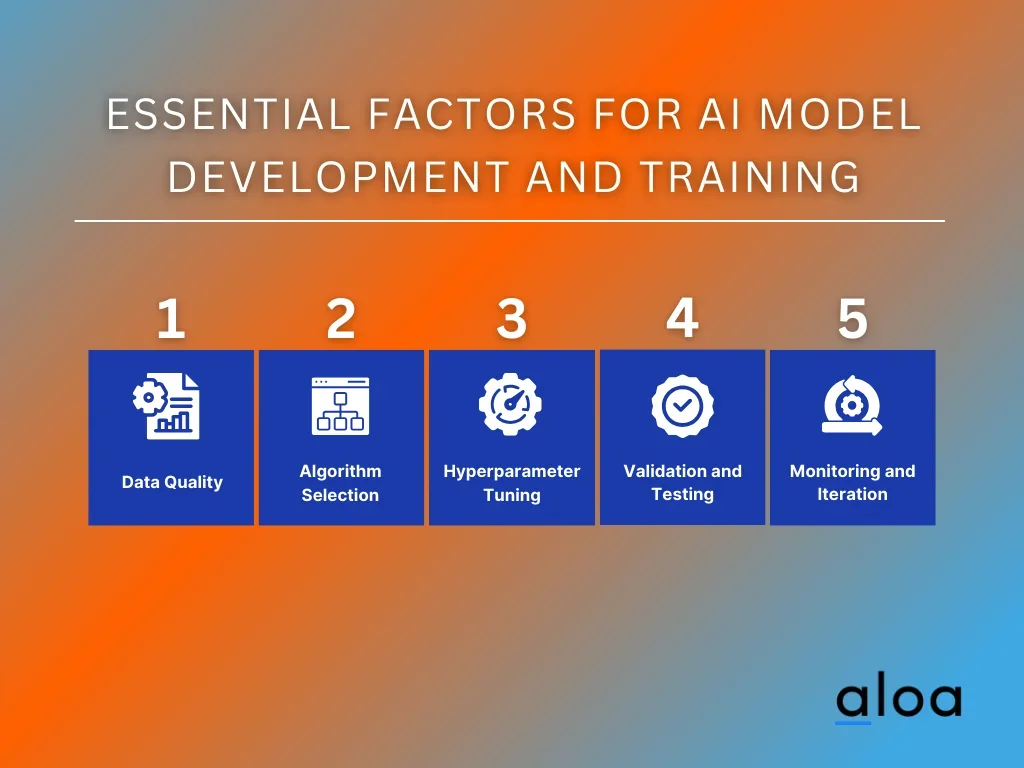
- Data Quality: Ensure the data provided for training is highly relevant and representative of the problem domain. Verify the relevance of the data to the problem at hand and its representativeness in real-world scenarios.
- Algorithm Selection: Choose appropriate algorithms based on the problem's nature and the data's characteristics. Consider factors like scalability, interpretability, and computational efficiency when selecting algorithms.
- Hyperparameter Tuning: Fine-tune model parameters to optimize performance and generalization ability. Experiment with different combinations of hyperparameters and evaluate their impact on model performance using techniques like cross-validation.
- Validation and Testing: Validate the trained model using separate datasets and test its accuracy and effectiveness. Employ techniques like k-fold cross-validation or bootstrapping to ensure robust validation results.
- Monitoring and Iteration: Monitor model performance and iterate on the training process to improve results. Iteratively refine the model through additional training iterations or adjustments to the training pipeline.
Step 6: Conduct Rigorous Testing and Evaluation
Now that you've developed and trained your AI models, it's time to put them through their paces with rigorous testing and evaluation. This step is crucial to ensure your AI-powered software functions as intended and delivers reliable results. Here are some key aspects to consider during this phase:
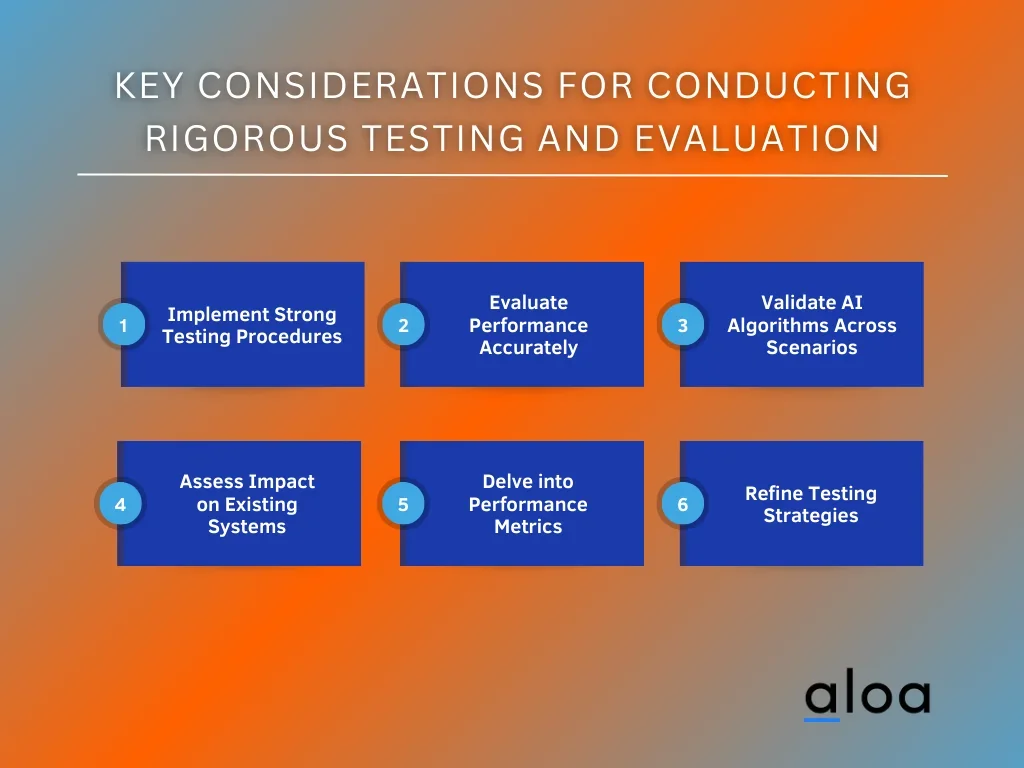
- Implement Strong Testing Procedures: Ensure you have robust testing procedures to validate your AI models and software functionality thoroughly.
- Evaluate Performance Accurately: Establish comprehensive evaluation mechanisms to assess the performance of your AI models accurately. Dive into the data and analyze the results to identify any potential issues.
- Validate AI Algorithms Across Scenarios: Test your AI algorithms across various scenarios to ensure their reliability in different use cases.
- Assess Impact on Existing Systems: Evaluate the impact of integrating AI into your existing systems to ensure everything runs smoothly without any unexpected issues.
- Embrace Performance Metrics: Dive into performance metrics to clearly understand your AI solutions' performance.
- Refine Testing Strategies: Continuously refine your testing strategies to adapt to evolving software requirements and advancements in AI technology.
Step 7: Embrace Continuous Learning and Improvement
In wrapping up the process, it's crucial to emphasize the significance of continuous learning and improvement in software development through the advent of AI. Stay updated with the latest advancements in AI to enhance software quality and strengthen job prospects in a competitive market. Adapting to the changing landscape of AI and programming is crucial to remaining competitive and relevant.
Moreover, you can harness the power of AI as a tool for innovation and efficiency by integrating it into your daily work routines. This integration allows for exploring new possibilities and creating more innovative, sophisticated software solutions. A commitment to ongoing learning ensures you can effectively navigate the complexities of AI-driven software development, ultimately driving progress and success in your career.
Key Takeaway
Examining the question, “Will AI replace programmers?” is crucial for navigating the future of software development. This question significantly impacts the role of human programmers and the evolution of technology-driven industries. Today, it's a pivotal consideration in shaping innovation and workforce dynamics.
Recognizing how to grasp this concept empowers individuals and organizations to make informed decisions about technology and human resource investments. It involves evaluating factors like AI's coding and software development capabilities, potential job role impacts, and opportunities for human-AI collaboration.
Looking to learn more about the rising AI trends? Explore the Aloa blog and discover how AI is reshaping key industries with our insightful reads: AI in Healthcare and AI in FinTech. Don’t miss out on the transformative potential of AI in revolutionizing healthcare and financial technology. Sign up for our newsletter today to receive the latest blog posts and be at the forefront of AI innovation!

